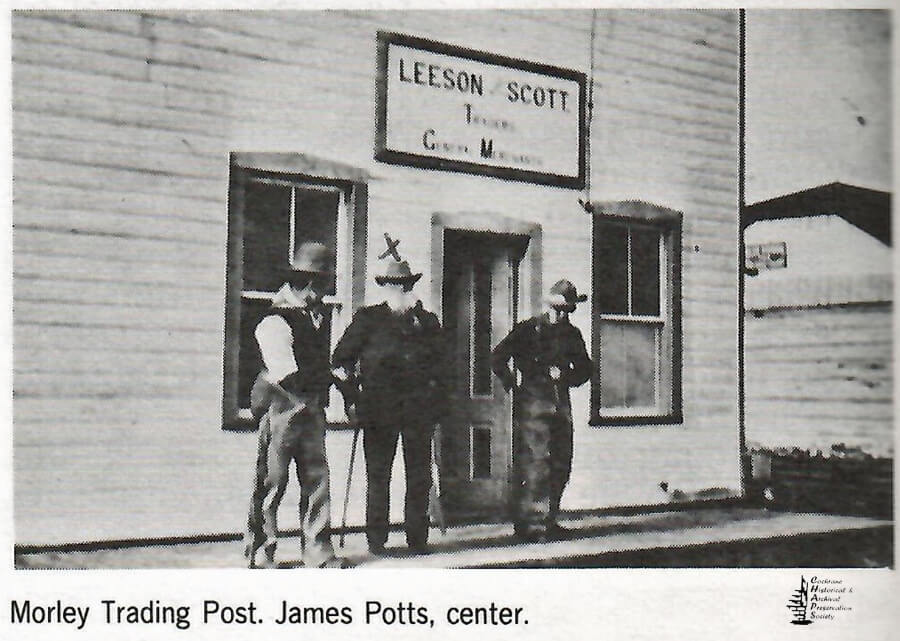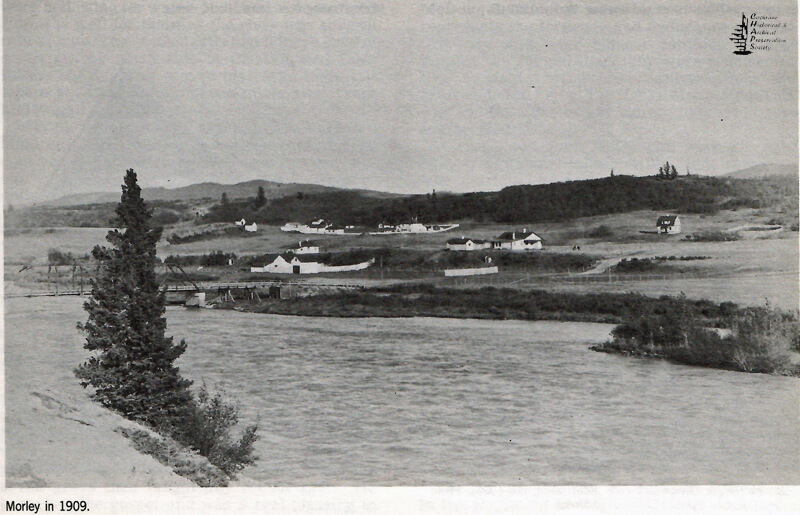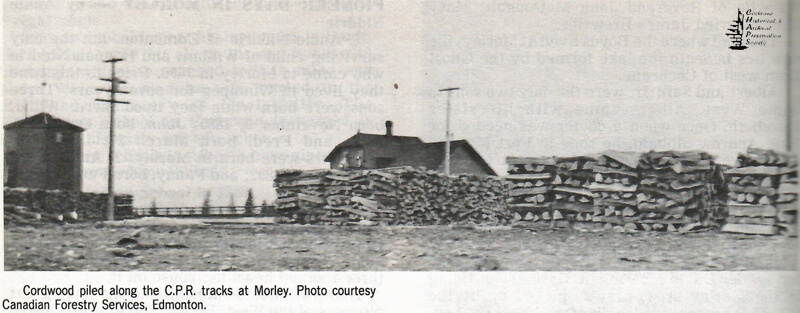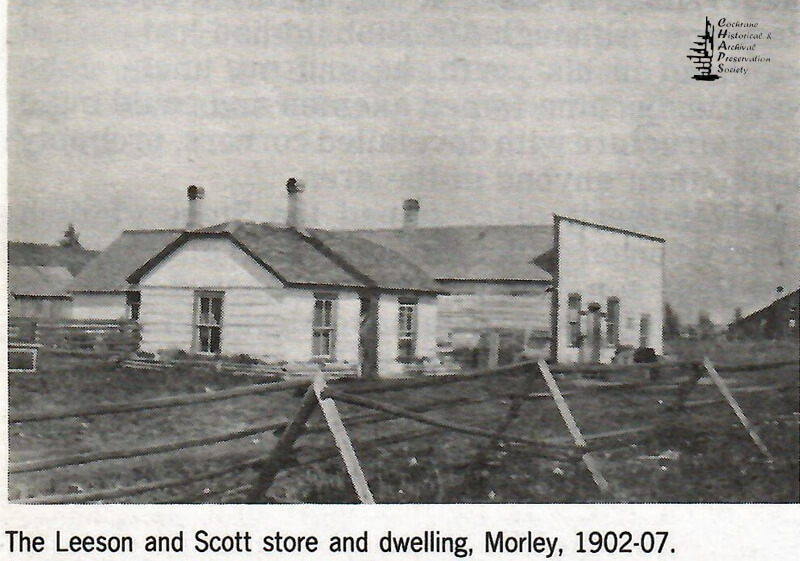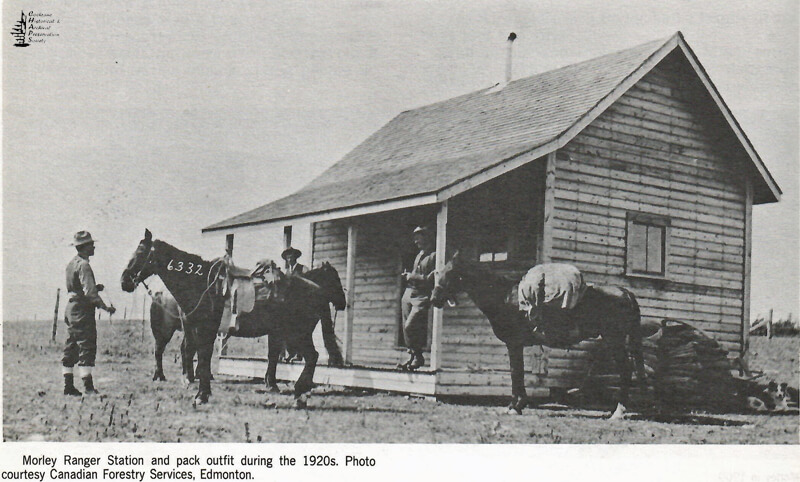By Annie Niddrie Page 81 Big Hill Country 1977
I, Annie Niddrie of Edmonton, am the only surviving child of William and Hannah Niddrie who came to Morley in 1890. Prior to this time, they lived in Winnipeg for seven years. Three sons were born while they lived there: Willie, born November 3, 1885; John, born October 2, 1887; and Fred, born March 27, 1890. Two daughters were born in Morley: I, Annie, born February 18, 1892; and Fanny, born February 18, 1894.
At Morley, my parents decided to start a cattle ranch. They bought a quarter section of land from Andrew Sibbald for $700.00. The land was partly improved. I think it was fenced and had a three-roomed hewn log house on it.
Andrew Sibbald rates among the truly great pioneers of the West. He was the first teacher in the territory of Alberta, long before it became a Province. Although Mr. Sibbald had lost part of one hand in his youth, he and my uncle, John Niddrie, became famed axemen and could build a log structure with dovetailed corners, probably better than anyone in the area.
My father’s place joined the Stoney Indian Reserve on one side. Mr. and Mrs. Sam Fletcher and their son Arthur, who neighbored with my parents in Winnipeg, came to Morley in 1889 and had a cattle ranch three miles away. The Potts and Warnocks also played a noble part in pioneering at Morley. Reverend George McDougall was the first missionary to settle at Morley and his son John followed in his footsteps.
There were Indians (sic) everywhere. They all rode horseback. Often the mother rode in the center and had a child in front of her and one at the back. After giving birth, a mother often named a new baby after the first object she saw such as: Mark Poucette, Johnny Powderface, David Bigstoney, Johnny Two Young Man and Walking Buffalo.
There were no modern conveniences. The washing had to be done on a washboard. There were no bathtubs or indoor bathrooms. The mothers usually sewed all the children’s clothes, dad’s shirts, and knit all the stockings and mitts by hand. Everybody burned wood in the stoves. The wood had to be cut with an axe or sawed by hand. The water had to be pumped from the well and carried to the house in pails and heated on top of the stove for washing and scrubbing.
Times were hard. There wasn’t any income except for the sale of a few fat steers in the fall, which sold on foot for three or four cents a pound. It took a large animal to sell for thirty-three or thirty-four dollars.
Tuberculosis had never been heard of in Canada until the white people came to live among the Indians (sic), and then it spread like wildfire. The Indians (sic) called it: “The White Man’s Plague.” It was many years before “Sans” were built and this dreaded disease came under control.
We had several dry years in the Morley area so my parents decided a change must be made. Feed for the cattle couldn’t be had and the cattle were bellowing for water. It all had to be pumped from the well for them as the river was several miles away. The McDougalls had a large herd of cattle on the north side of the Big Red Deer River. My dad also moved his cattle there but took a squatter’s claim seven miles away from McDougall’s ranch.
My parents sold their ranch in Morley for six hundred dollars to Mr. Graham in 1894. Every cent had to be traded out at Graham’s store. Not one cent of cash was given out. Hundreds of dollars’ worth of work had been put on the place.
Three Morley families moved to the Big Red Deer area: Lucius Coleman, Arthur Fletcher and William Niddrie. Mr. Coleman, a Justice of the Peace and graduate of Victoria University at Cobourg, Ontario, was a gentleman in every sense of the word.
At our new location, there was hay and water everywhere and the cattle thrived. We milked cows and raised chickens and had milk and butter for our use.
My uncle, John Niddrie, came to Morley in 1889. The Reverend John McDougall invited him to come and start work among the Indians (sic). He helped on the ranch and also with the Church work. He taught the Indian (sic) day school for four years and supervised the Indian (sic) orphanage for seven years then taught day school again. He preached the gospel and was a real blessing to
Morley. My grandmother, Jane Niddrie, had lived with John, her son, for some time and died in 1894, just eight days before Margaret Fletcher passed away. They were buried side by side in the Morley graveyard.
Later, John Niddrie received his ordination in Winnipeg. After twenty years in Morley, he was transferred by the Methodist Church to Oxford House, Manitoba. He spent five years there and was then moved to Island Lake. He spent another five years there and again moved to Berens River, which is one hundred and fifty miles north of Winnipeg. He remained there for twenty years. He mastered three Indian languages and was known all over the North. He had helped to raise seventeen Indian (sic) boys. His picture hangs among those of other pioneers in the McDougall Church at Morley. His work was finished when he passed away at Berens River, May 4, 1940, at the age of 76, after preaching the gospel for forty-eight years.

